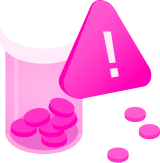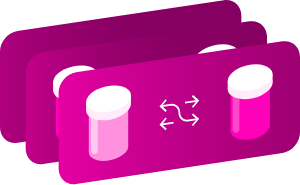Identification
- Summary
-
Aurothioglucoseis a gold compound used in the treatment of rheumatoid arthritis.
- Generic Name
- Aurothioglucose
- DrugBank Accession Number
- DB09121
- Background
-
Aurothioglucose, also known as gold thioglucose, was formerly used to treat rheumatoid arthritis.
Contemporary research on the effect of gold salts treatment began in 1935, primarily to reduce inflammation and to slow disease progression in patients with rheumatoid arthritis2。The use of gold compounds has decreased since the 1980s owing to numerous side effects, limited efficacy, and slow onset of action. Many if not most gold compounds that were indicated for rheumatoid arthritis therapy have since been replaced with the use of various current disease modifying anti-rheumatic drugs (DMARDs) like methotrexate and others, which are far more effective.
- Type
- Small Molecule
- Groups
- Approved, Withdrawn
- Structure
- Weight
-
Average: 392.18
Monoisotopic: 391.999289 - Chemical Formula
- C6H11AuO5S
- Synonyms
-
- Auromyose
- Aurothioglucose
- Gold thioglucose
Pharmacology
- Indication
-
Aurothioglucose is indicated for the adjunctive treatment of early active adult and juvenile type rheumatoid arthritis that is not adequately controlled by other anti-inflammatory agents and conservative measures like salicylate, glucocorticoids, etc.5,6。In chronic, advanced cases of rheumatoid arthritis, such gold therapy is not demonstrated to be as valuable6。
Antirheumatic measures such as salicylate and other anti-inflammatory drugs (both steroidal and non steroidal) may be continued after initiation of gold therapy6。After improvement commences, these measures may be discontinued slowly as symptoms permit6。
 Reduce drug development failure ratesBuild, train, & validate machine-learning models
Reduce drug development failure ratesBuild, train, & validate machine-learning models
with evidence-based and structured datasets.Build, train, & validate predictive machine-learning models with structured datasets. - Contraindications & Blackbox Warnings
-
 Avoid life-threatening adverse drug eventsImprove clinical decision support with information oncontraindications & blackbox warnings, population restrictions, harmful risks, & more.Avoid life-threatening adverse drug events & improve clinical decision support.
Avoid life-threatening adverse drug eventsImprove clinical decision support with information oncontraindications & blackbox warnings, population restrictions, harmful risks, & more.Avoid life-threatening adverse drug events & improve clinical decision support. - Pharmacodynamics
-
After administration, patient serum levels of gold rise sharply but decline over the following week6。峰值与水准备更高and decline faster than those with oily preparations6。Regular weekly administration produces a continuous rise in the basal value for several months, after which the serum level becomes relatively stable6。After a standard weekly dose, considerable individual variation in the levels of gold can be observed6。A steady decline in gold levels occurs when the interval between injections is lengthened, and small amounts may be found in the serum for months after discontinuation of therapy6。The incidence of toxic reactions is seemingly unrelated to the plasma level of gold, but may perhaps be more associated with the total cumulative content of gold in the body6。
- Mechanism of action
-
Rheumatoid arthritis is an autoimmune disease in which the body's immune system mistakenly attacks the lining of various skeletal bone joints of the body1,9。These attacks are facilitated by various pro-inflammatory immune cells and agents like cytokines, histamines, mast cells, macrophages, monocytes, lymphocytes, leukocytes, and many others1。The longterm result of this unwanted immune response is chronic inflammation and painful tissue damage1,9。The cause of the malfunctioning immune system in rheumatoid arthritis is unknown and there is no definitive cure for the condition1,9。
Similarly, the mechanism of action of aurothioglucose is also not well elucidated. Nevertheless, some studies have suggested that the combination of both the sulfhydryl ligand and aureus cation present in aurothioglucose elicits an inhibitory effect on adenylyl cyclase activity in human lymphocyte membranes and in membranes of T and B lymphocyte subsets1。特别是,这种活动的抑制of adenylyl cyclase and its various isoforms would theoretically also limit the cyclases' ability to induce mast cell degranulation and histamine release, to enhance respiratory burst effects, to stimulate the action of resting macrophages, to induce and activate phagocytes, to induce neutrophil chemotaxis, etc. - all of which are pro-inflammatory actions1。
Target Actions Organism UAdenylate cyclase type 1 Not Available Humans UAdenylate cyclase type 2 Not Available Humans UAdenylate cyclase type 5 Not Available Humans - Absorption
-
In general, aurothioglucose is administered via intramuscular injection - preferably intragluteally8- after which the resultant absorption is typically slow and erratic4。
Gold is absorbed from injection sites, reaching peak concentration in blood in about 4 to 6 hours6。After a single intramuscular injection of 50 mg of aurothioglucose suspension in two subjects, peak serum levels were observed at approximately 235 g/dL and 450 g/dL6。
Storage of gold in human tissues depends upon organ mass as well as the concentration of gold6。Subsequently, tissues having the highest gold levels (w/w) may not necessarily have the largest total amounts of gold6。The highest concentrations of gold are generally found in the lymph nodes, adrenal glands, liver, kidneys, bone marrow, and spleen6。Relatively small concentrations are actually found in the articular structures6。In particular, following the administration of aurothioglucose doses, about 85% of the resultant plasma gold will be stored in the major bodily gold depots, which in decreasing order of total gold content are, the lymph nodes, bone marrow, liver, skin, and bone6,8。
- Volume of distribution
-
Readily accessible data regarding the volume of distribution of aurothioglucose is not available.
- Protein binding
-
In plasma, 95-99% of the drug is bound to albumin fraction5,3。
- Metabolism
-
Although the exact metabolic fate of aurothioglucose is not formally understood, the principal gold species that can be found in the urine and blood of a patient following the administration of the drug is [Au(CN)2]-5。
- Route of elimination
-
Following a single intramuscular injection of 50 mg aurothioglucose in each of two patients, one study determined that approximately 70% of the agent is eliminated in the urine and 30% in the faeces5。In general, excretion is primarily in the urine3。
- Half-life
-
The biological half-life of gold salts (like aurothioglucose) following a single 50 mg dose demonstrates a biological half-life of about 3-27 days, where the half-life seemingly increases with increased number of doses3。Following successive weekly doses, the half-life increases and may become 14-40 days after the third dose and up to 168 days after the eleventh weekly dose5。
- Clearance
-
When a standard weekly treatment schedule of aurothioglucose administrations is followed, about 40% of the given dose is excreted each week, while the remainder is excreted over a longer period6。
- Adverse Effects
-
 提高决策支持&research outcomesWith structured adverse effects data, including:blackbox warnings, adverse reactions, warning & precautions, & incidence rates.提高决策支持&research outcomes with our structured adverse effects data.
提高决策支持&research outcomesWith structured adverse effects data, including:blackbox warnings, adverse reactions, warning & precautions, & incidence rates.提高决策支持&research outcomes with our structured adverse effects data. - Toxicity
-
Overdose as a result of too rapid increases in dosing with aurothioglucose will be manifested by rapid appearance of toxic reactions, including those that are particular to renal damage, like hematuria and proteinuria, while hematologic effects include thrombocytopenia and granulocytopenia6。
Other toxic effects, including fever, nausea, vomiting, diarrhea, and various skin disorders like papulovesicular lesions, urticaria, and exfoliative dermatitis, each of which are typically combined with severe pruritus can also develop6。
The intramuscular TDLo for males is reported to be approximately 3.357 mg/kg when considering sense organs and special senses like eye vision and about 5.5 mg/kg for affects on the lungs, thorax, or respiration7。For women, the intramuscular TDLo for effects on the liver, gastrointestinal tract, and cholestatic jaundice is between 2.6-2.7 mg/kg while the value for effects on the kidney, ureter, bladder, and acute renal failure, acute tubular necrosis, and other changes in urine composition is about 14.402 mg/kg7。
- Pathways
- Not Available
- Pharmacogenomic Effects/ADRsBrowse all" title="" id="snp-actions-info" class="drug-info-popup" href="javascript:void(0);">
- Not Available
Interactions
- Drug InteractionsLearn More" title="" id="structured-interactions-info" class="drug-info-popup" href="javascript:void(0);">
-
This information should not be interpreted without the help of a healthcare provider. If you believe you are experiencing an interaction, contact a healthcare provider immediately. The absence of an interaction does not necessarily mean no interactions exist.
Drug Interaction Integrate drug-drug
interactions in your softwareAbacavir Abacavir may decrease the excretion rate of Aurothioglucose which could result in a higher serum level. Aceclofenac Aceclofenac may decrease the excretion rate of Aurothioglucose which could result in a higher serum level. Acemetacin Acemetacin may decrease the excretion rate of Aurothioglucose which could result in a higher serum level. Acetaminophen Acetaminophen may decrease the excretion rate of Aurothioglucose which could result in a higher serum level. Acetazolamide Acetazolamide may increase the excretion rate of Aurothioglucose which could result in a lower serum level and potentially a reduction in efficacy. Acetylsalicylic acid Acetylsalicylic acid may decrease the excretion rate of Aurothioglucose which could result in a higher serum level. Aclidinium Aclidinium may decrease the excretion rate of Aurothioglucose which could result in a higher serum level. Acrivastine Aurothioglucose may decrease the excretion rate of Acrivastine which could result in a higher serum level. Acyclovir Acyclovir may decrease the excretion rate of Aurothioglucose which could result in a higher serum level. Adefovir dipivoxil Adefovir dipivoxil may decrease the excretion rate of Aurothioglucose which could result in a higher serum level.  Identify potential medication risksEasily compare up to 40 drugs with our drug interaction checker.Get severity rating, description, and management advice.Learn more
Identify potential medication risksEasily compare up to 40 drugs with our drug interaction checker.Get severity rating, description, and management advice.Learn more - Food Interactions
- Not Available
Products
-
 Drug product information from 10+ global regionsOur datasets provide approved product information including:
Drug product information from 10+ global regionsOur datasets provide approved product information including:
dosage, form, labeller, route of administration, and marketing period.Access drug product information from over 10 global regions. - International/Other Brands
- Brenol/Oronol/Romosol/Solganal/Solganal B
- Brand Name Prescription Products
-
Name Dosage Strength Route Labeller Marketing Start Marketing End Region Image Solganal Inj 50mg/ml Suspension 50 mg / mL Intramuscular Schering Plough 1940-12-31 2003-07-14 Canada
Categories
- ATC Codes
- M01CB04 — Aurothioglucose
- Drug Categories
- Chemical TaxonomyProvided byClassyfire
-
- Description
- This compound belongs to the class of organic compounds known as hexoses. These are monosaccharides in which the sugar unit is a is a six-carbon containing moeity.
- Kingdom
- Organic compounds
- Super Class
- Organic oxygen compounds
- Class
- Organooxygen compounds
- Sub Class
- Carbohydrates and carbohydrate conjugates
- Direct Parent
- Hexoses
- Alternative Parents
- Oxanes/二级醇/Polyols/Oxacyclic compounds/Organic transition metal salts/Primary alcohols/Organosulfur compounds/Organic zwitterions/Hydrocarbon derivatives
- Substituents
- Alcohol/Aliphatic heteromonocyclic compound/Hexose monosaccharide/Hydrocarbon derivative/Organic salt/Organic transition metal salt/Organic zwitterion/Organoheterocyclic compound/Organosulfur compound/Oxacycle
- Molecular Framework
- Aliphatic heteromonocyclic compounds
- External Descriptors
- oxanes (CHEBI:2930)
- Affected organisms
-
- Humans and other mammals
Chemical Identifiers
- UNII
- 2P2V9Q0E78
- CAS number
- 12192-57-3
- InChI Key
- XHVAWZZCDCWGBK-WYRLRVFGSA-M
- InChI
-
InChI=1S/C6H12O5S.Au/c7-1-2-3(8)4(9)5(10)6(12)11-2;/h2-10,12H,1H2;/q;+1/p-1/t2-,3-,4+,5-,6-;/m1./s1
- IUPAC Name
-
{[(2R,3R,4S,5S,6R)-3,4,5-trihydroxy-6-(hydroxymethyl)oxan-2-yl]sulfanyl}gold
- SMILES
-
OC[C@H]1O[C@H](S[Au])[C@H](O)[C@@H](O)[C@@H]1O
References
- 一般References
-
- Botz B, Bolcskei K, Kereskai L, Kovacs M, Nemeth T, Szigeti K, Horvath I, Mathe D, Kovacs N, Hashimoto H, Reglodi D, Szolcsanyi J, Pinter E, Mocsai A, Helyes Z: Differential regulatory role of pituitary adenylate cyclase-activating polypeptide in the serum-transfer arthritis model. Arthritis Rheumatol. 2014 Oct;66(10):2739-50. doi: 10.1002/art.38772. [Article]
- Shaw III CF: Gold-based therapeutic agents. Chem Rev. 1999 Sep 8;99(9):2589-600. [Article]
- Arthur H. Jeske (2017). Mosby's Dental Drug Reference - E-Book (pp. 120-122). Elsevier Health Sciences. [ISBN:9780323511216]
- Ronald I. Shorr (2007). Drugs for the Geriatric Patient . Elsevier Health Sciences. [ISBN:9781437710359]
- NLM Toxnet Toxicology Data Network: Aurothioglucose [Link]
- RXmed: Solganal (Aurothioglucose) Monograph [Link]
- ChemIDplus: Aurothioglucose [USP] [Link]
- ScienceDirect: Aurothioglucose [Link]
- Arthritis Society: Rheumatoid Arthritis [Link]
- External Links
- MSDS
-
Download (118 KB)
Clinical Trials
- Clinical TrialsLearn More" title="" id="clinical-trials-info" class="drug-info-popup" href="javascript:void(0);">
-
Phase Status Purpose Conditions Count
Pharmacoeconomics
- Manufacturers
-
Not Available
- Packagers
-
Not Available
- Dosage Forms
-
Form Route Strength Suspension Intramuscular 50 mg / mL - Prices
- Not Available
- Patents
- Not Available
Properties
- State
- Liquid
- Experimental Properties
- Not Available
- Predicted Properties
-
Property Value Source Water Solubility 96.4 mg/mL ALOGPS logP -1.8 ALOGPS logP -2.2 Chemaxon logS -0.61 ALOGPS pKa (Strongest Acidic) 12.51 Chemaxon pKa (Strongest Basic) -3 Chemaxon Physiological Charge 0 Chemaxon Hydrogen Acceptor Count 5 Chemaxon Hydrogen Donor Count 4 Chemaxon Polar Surface Area 90.15 Å2 Chemaxon Rotatable Bond Count 2 Chemaxon Refractivity 41.25 m3·mol-1 Chemaxon Polarizability 19.88 Å3 Chemaxon Number of Rings 1 Chemaxon Bioavailability 1 Chemaxon Rule of Five Yes Chemaxon Ghose Filter No Chemaxon Veber's Rule No Chemaxon MDDR-like Rule No Chemaxon - Predicted ADMET Features
- Not Available
Spectra
- Mass Spec (NIST)
- Not Available
- Spectra
-
Spectrum Spectrum Type Splash Key Predicted GC-MS Spectrum - GC-MS Predicted GC-MS Not Available
Targets

insights and accelerate drug research.
- Kind
- Protein
- Organism
- Humans
- 药理作用
-
Unknown
- General Function
- Metal ion binding
- Specific Function
- Catalyzes the formation of the signaling molecule cAMP in response to G-protein signaling. Mediates responses to increased cellular Ca(2+)/calmodulin levels (By similarity). May be involved in regu...
- Gene Name
- ADCY1
- Uniprot ID
- Q08828
- Uniprot Name
- Adenylate cyclase type 1
- 分子量
- 123438.85 Da
References
- NLM Toxnet Toxicology Data Network: Aurothioglucose [Link]
- Kind
- Protein
- Organism
- Humans
- 药理作用
-
Unknown
- General Function
- Protein heterodimerization activity
- Specific Function
- Catalyzes the formation of the signaling molecule cAMP in response to G-protein signaling (PubMed:15385642). Down-stream signaling cascades mediate changes in gene expression patterns and lead to i...
- Gene Name
- ADCY2
- Uniprot ID
- Q08462
- Uniprot Name
- Adenylate cyclase type 2
- 分子量
- 123602.25 Da
References
- NLM Toxnet Toxicology Data Network: Aurothioglucose [Link]
- Kind
- Protein
- Organism
- Humans
- 药理作用
-
Unknown
- General Function
- Protein heterodimerization activity
- Specific Function
- Catalyzes the formation of the signaling molecule cAMP in response to G-protein signaling (PubMed:15385642, PubMed:26206488, PubMed:24700542). Mediates signaling downstream of ADRB1 (PubMed:2470054...
- Gene Name
- ADCY5
- Uniprot ID
- O95622
- Uniprot Name
- Adenylate cyclase type 5
- 分子量
- 138906.37 Da
References
- NLM Toxnet Toxicology Data Network: Aurothioglucose [Link]
Drug created at September 22, 2015 21:48 / Updated at February 21, 2021 18:52




